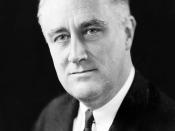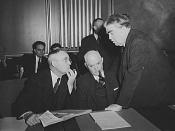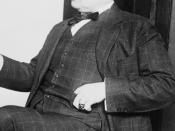In 1935 the citizens of the U.S. were still struggling to put back together the many losses, from due effects of the depression, leaving people to question the idea of the American dream. What was once the land of hope and optimism became the land of despair, as the American people were questioning all the maxims on which they had based their lives - democracy, capitalism, and individualism. The economy during the depression had been so significantly damaged that none had escaped living through the harsh effects of economic plummet and struggle. This concerning subject thus dominated political discussion and policy in 1935 and through out the 1930's. Commissions were set up to regulate Wall Street, the banking industry and other business enterprises. The U.S. became a nation of high expectation on government in terms of control, insurance and welfare; although more than anything, the citizens of the U.S. desired change from what had brought them so much misery.
John L. Lewis, president of the UVM, in the AFL in 1935 sensed this need for change, and brought it about in a new form of unionism, industrial unionism. Just over 10 years earlier unionism had suffered its biggest defeat, with the success of government and employer "union-busting". Still, the AFL was as static in its approach to organize labor as it had always been, not following labor evolving need and taking risk, focusing purely on organizing skilled workers. Yet a man would fight against this direction and begin to revolutionize unionism, taking his own direction, this man being John L. Lewis. Lewis, felt organizing mass production workers was to be the new, and better, form of unionism, yet the president of the AFL, William Green, felt otherwise, expressing the need to focus on skill workers. However Lewis' conviction in...


